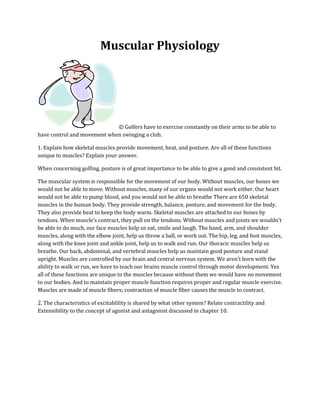
Muscular physiology
- 1. Muscular Physiology © Golfers have to exercise constantly on their arms to be able to have control and movement when swinging a club. 1. Explain how skeletal muscles provide movement, heat, and posture. Are all of these functions unique to muscles? Explain your answer. When concerning golfing, posture is of great importance to be able to give a good and consistent hit. The muscular system is responsible for the movement of our body. Without muscles, our bones we would not be able to move. Without muscles, many of our organs would not work either. Our heart would not be able to pump blood, and you would not be able to breathe There are 650 skeletal muscles in the human body. They provide strength, balance, posture, and movement for the body. They also provide heat to keep the body warm. Skeletal muscles are attached to our bones by tendons. When muscle's contract, they pull on the tendons. Without muscles and joints we wouldn't be able to do much, our face muscles help us eat, smile and laugh. The hand, arm, and shoulder muscles, along with the elbow joint, help us throw a ball, or work out. The hip, leg, and foot muscles, along with the knee joint and ankle joint, help us to walk and run. Our thoracic muscles help us breathe. Our back, abdominal, and vertebral muscles help us maintain good posture and stand upright. Muscles are controlled by our brain and central nervous system. We aren't born with the ability to walk or run, we have to teach our brains muscle control through motor development. Yes all of these functions are unique to the muscles because without them we would have no movement to our bodies. And to maintain proper muscle function requires proper and regular muscle exercise. Muscles are made of muscle fibers; contraction of muscle fiber causes the muscle to contract. 2. The characteristics of excitablility is shared by what other system? Relate contractility and Extensibility to the concept of agonist and antagonist discussed in chapter 10.
- 2. © 3. What structures are unique to skeletal muscle fibers? Which of the structures involved primarily in contractility and which are in invloved in excitability? 4.Explain how the structure of the myofilaments is related to their function. - Myofilament is composed of protein strings of actin and myosin that pack a muscle fiber. -Actin and Myosin are the force generating structures. -Myofilaments contract or shorten due to interactions between myosin and actin filaments. 5.Explain how the sliding filament theory allows for the shortening of a muscle fiber. The shortening of a muscle fiber happens when extensible region pulls the filaments across each other. 6. Compare and contrast the role of Ca++ in excitation, contraction, and relaxation of a muscle cell. The contractions necessary to hold the club above the shoulder and swing in the blink of an eye are remarkably different, yet run so smoothly. © Excitation is what sends signals to start contractions. It builds up the Calcium that gets released during contractions.
- 3. Contractions Sarcoplasmic reticulum sacs empty Calcium into the sarcoplasm. The calcium ions bind with troponin molecules until relaxation when the ions and molecules are separated (1). Relaxation is the stage where the Calcium is gathered back up and the contraction has finished. All three stages are about the movement of Calcium but the use of Calcium is different (Excitation=growth=stimulus signal, Contraction=release=causes movement, and Relaxation=recovery=end of movement). 7. People who exercise seiously are sometimes told to work a muscle until they "feel the burn". In terms of how muscle is able to release energy, explain what is going on in the muscle early in the exercise and when the muscle is "burning." The muscles burning while a person is exercising are the muscle cells running out of oxygen. The body then produces lactic acid to convert into energy for the muscle cells. Lactic acid uses less oxygen and can increase the burning sensation (5). 8. Describe the anatomical arrangement of a motor unit. Contrast fine and gross motor units. A motor unit is group of muscle fibers and the motor neuron they are attached to. A fine motor unit is when the group has a small amount of fibers (i.e. 10 fibers). Unlike a gross motor unit where there are many fibers (i.e. 500 fibers). (1). © 13: Phases of a muscle contraction A muscle contraction in response to a single nerve action potential is called a twitch contraction. A myogram, a graph of muscle strength (tension) with time, shows several phases, shown in Figure 1: 1. The latent period is the time required for the release of Ca2+. 2. The contraction period represents the time during actual muscle contraction. 3. The relaxation period is the time during which Ca2+ are returned to the sarcoplasmic reticulum by active transport. 4. The refractory period is the time immediately following a stimulus. This is the time period when a muscle is contracting and therefore will not respond to a second stimulus. Since this
- 4. is occurring at the same time as the contraction, it does not appear on the myogram as a separate event. 14: Treppe Effect The concept or phenomenon of "Treppe" occurs when a muscle contracts more forcefully after it has contracted a few times than when it first contracts. This is due to the fact that active muscles require decreasing degrees of succeeding stimuli to elicit maximal contractions. Returning to our example of the second set of squats feeling easier than the first, during the first set there was insufficient warm-up, and the second set felt easier because the first set actually served as a warm- up. The phenomenon in which the contraction strength of a muscle increases, due to increased Ca2+ availability and enzyme efficiency during the warm-up. Golfers need to warm-up too; all that practice is what makes a golfer’s movements so fluid.